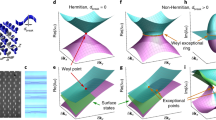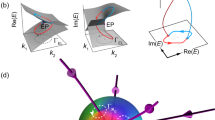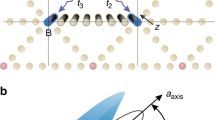Abstract
The Dirac cone underlies many unique electronic properties of graphene1 and topological insulators, and its band structure—two conical bands touching at a single point—has also been realized for photons in waveguide arrays2, atoms in optical lattices3, and through accidental degeneracy4,5. Deformation of the Dirac cone often reveals intriguing properties; an example is the quantum Hall effect, where a constant magnetic field breaks the Dirac cone into isolated Landau levels. A seemingly unrelated phenomenon is the exceptional point6,7, also known as the parity–time symmetry breaking point8,9,10,11, where two resonances coincide in both their positions and widths. Exceptional points lead to counter-intuitive phenomena such as loss-induced transparency12, unidirectional transmission or reflection11,13,14, and lasers with reversed pump dependence15 or single-mode operation16,17. Dirac cones and exceptional points are connected: it was theoretically suggested that certain non-Hermitian perturbations can deform a Dirac cone and spawn a ring of exceptional points18,19,20. Here we experimentally demonstrate such an ‘exceptional ring’ in a photonic crystal slab. Angle-resolved reflection measurements of the photonic crystal slab reveal that the peaks of reflectivity follow the conical band structure of a Dirac cone resulting from accidental degeneracy, whereas the complex eigenvalues of the system are deformed into a two-dimensional flat band enclosed by an exceptional ring. This deformation arises from the dissimilar radiation rates of dipole and quadrupole resonances, which play a role analogous to the loss and gain in parity–time symmetric systems. Our results indicate that the radiation existing in any open system can fundamentally alter its physical properties in ways previously expected only in the presence of material loss and gain.
This is a preview of subscription content, access via your institution
Access options
Subscribe to this journal
Receive 51 print issues and online access
$199.00 per year
only $3.90 per issue
Buy this article
- Purchase on Springer Link
- Instant access to full article PDF
Prices may be subject to local taxes which are calculated during checkout



Similar content being viewed by others
References
Castro Neto, A. H., Guinea, F., Peres, N. M. R., Novoselov, K. S. & Geim, A. K. The electronic properties of graphene. Rev. Mod. Phys. 81, 109–162 (2009)
Rechtsman, M. C. et al. Strain-induced pseudomagnetic field and photonic landau levels in dielectric structures. Nature Photon. 7, 153–158 (2013)
Tarruell, L., Greif, D., Uehlinger, T., Jotzu, G. & Esslinger, T. Creating, moving and merging Dirac points with a Fermi gas in a tunable honeycomb lattice. Nature 483, 302–305 (2012)
Huang, X., Lai, Y., Hang, Z. H., Zheng, H. & Chan, C. Dirac cones induced by accidental degeneracy in photonic crystals and zero-refractive-index materials. Nature Mater. 10, 582–586 (2011)
Moitra, P. et al. Realization of an all-dielectric zero-index optical metamaterial. Nature Photon. 7, 791–795 (2013)
Moiseyev, N. Non-Hermitian Quantum Mechanics (Cambridge Univ. Press, 2011)
Rotter, I. A non-Hermitian Hamilton operator and the physics of open quantum systems. J. Phys. A 42, 153001 (2009)
Bender, C. M. & Boettcher, S. Real spectra in non-Hermitian Hamiltonians having PT symmetry. Phys. Rev. Lett. 80, 5243–5246 (1998)
Rüter, C. E. et al. Observation of parity–time symmetry in optics. Nature Phys. 6, 192–195 (2010)
Chong, Y., Ge, L. & Stone, A. D. PT-symmetry breaking and laser-absorber modes in optical scattering systems. Phys. Rev. Lett. 106, 093902 (2011)
Regensburger, A. et al. Parity-time synthetic photonic lattices. Nature 488, 167–171 (2012)
Guo, A. et al. Observation of PT-symmetry breaking in complex optical potentials. Phys. Rev. Lett. 103, 093902 (2009)
Lin, Z. et al. Unidirectional invisibility induced by PT-symmetric periodic structures. Phys. Rev. Lett. 106, 213901 (2011)
Peng, B. et al. Parity–time-symmetric whispering-gallery microcavities. Nature Phys. 10, 394–398 (2014)
Liertzer, M. et al. Pump-induced exceptional points in lasers. Phys. Rev. Lett. 108, 173901 (2012)
Hodaei, H., Miri, M.-A., Heinrich, M., Christodoulides, D. N. & Khajavikhan, M. Parity-time–symmetric microring lasers. Science 346, 975–978 (2014)
Feng, L., Wong, Z. J., Ma, R.-M., Wang, Y. & Zhang, X. Single-mode laser by parity-time symmetry breaking. Science 346, 972–975 (2014)
Berry, M. Physics of nonhermitian degeneracies. Czech. J. Phys. 54, 1039–1047 (2004)
Makris, K., El-Ganainy, R., Christodoulides, D. & Musslimani, Z. H. Beam dynamics in PT symmetric optical lattices. Phys. Rev. Lett. 100, 103904 (2008)
Szameit, A., Rechtsman, M. C., Bahat-Treidel, O. & Segev, M. PT-symmetry in honeycomb photonic lattices. Phys. Rev. A 84, 021806 (2011)
Cao, H. & Wiersig, J. Dielectric microcavities: model systems for wave chaos and non-Hermitian physics. Rev. Mod. Phys. 87, 61–111 (2015)
Sakoda, K. Proof of the universality of mode symmetries in creating photonic Dirac cones. Opt. Express 20, 25181–25194 (2012)
Chan, C., Hang, Z. H. & Huang, X. Dirac dispersion in two-dimensional photonic crystals. Adv. Optoelectron. 2012, 313984 (2012)
Lee, J. et al. Observation and differentiation of unique high-Q optical resonances near zero wave vector in macroscopic photonic crystal slabs. Phys. Rev. Lett. 109, 067401 (2012)
Dembowski, C. et al. Experimental observation of the topological structure of exceptional points. Phys. Rev. Lett. 86, 787–790 (2001)
Hsu, C. W., DeLacy, B. G., Johnson, S. G., Joannopoulos, J. D. & Soljacic, M. Theoretical criteria for scattering dark states in nanostructured particles. Nano Lett. 14, 2783–2788 (2014)
Hsu, C. W. et al. Observation of trapped light within the radiation continuum. Nature 499, 188–191 (2013)
Suh, W., Wang, Z. & Fan, S. Temporal coupled-mode theory and the presence of non-orthogonal modes in lossless multimode cavities. IEEE J. Quantum Electron. 40, 1511–1518 (2004)
Chua, S.-L., Lu, L., Bravo-Abad, J., Joannopoulos, J. D. & Soljačić, M. Larger-area single-mode photonic crystal surface-emitting lasers enabled by an accidental Dirac point. Opt. Lett. 39, 2072–2075 (2014)
Lu, L., Joannopoulos, J. D. & Soljacic, M. Topological photonics. Nature Photon. 8, 821–829 (2014)
Acknowledgements
We thank T. Savas for fabrication of the samples, and F. Wang, Y. Yang, N. Rivera, S. Skirlo, O. Miller and S. G. Johnson for discussions. This work was partly supported by the Army Research Office through the Institute for Soldier Nanotechnologies under contract nos W911NF-07-D0004 and W911NF-13-D-0001. B.Z., L.L. and M.S. were partly supported by S3TEC, an Energy Frontier Research Center funded by the US Department of Energy under grant no. DE-SC0001299. L.L. was supported in part by the Materials Research Science and Engineering Center of the National Science Foundation (award no. DMR-1419807). I.K. was supported in part by Marie Curie grant no. 328853-MC-BSiCS.
Author information
Authors and Affiliations
Contributions
All authors discussed the results and made critical contributions to the work.
Corresponding authors
Ethics declarations
Competing interests
The authors declare no competing financial interests.
Supplementary information
Supplementary Information
This file contains Supplementary Text and Data, Supplementary References and Supplementary Figures 1–8. (PDF 9905 kb)
Rights and permissions
About this article
Cite this article
Zhen, B., Hsu, C., Igarashi, Y. et al. Spawning rings of exceptional points out of Dirac cones. Nature 525, 354–358 (2015). https://doi.org/10.1038/nature14889
Received:
Accepted:
Published:
Issue Date:
DOI: https://doi.org/10.1038/nature14889
This article is cited by
-
Creating pairs of exceptional points for arbitrary polarization control: asymmetric vectorial wavefront modulation
Nature Communications (2024)
-
Directive giant upconversion by supercritical bound states in the continuum
Nature (2024)
-
Analysis of Hermitian and non-Hermitian diabolic points and exceptional rings in parity-time symmetric ZRC and RLC dimers
Optical and Quantum Electronics (2024)
-
Design of unidirectional and tunable channels in two-dimensional photonic crystal composed of local PT symmetric structure
Journal of Optics (2024)
-
Detecting bulk and edge exceptional points in non-Hermitian systems through generalized Petermann factors
Frontiers of Physics (2024)
Comments
By submitting a comment you agree to abide by our Terms and Community Guidelines. If you find something abusive or that does not comply with our terms or guidelines please flag it as inappropriate.



